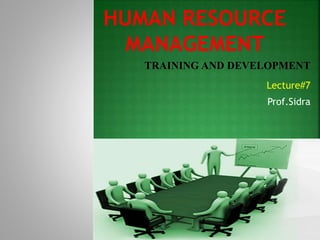
prof.sidra HRM 7th Lecture.pptx
- 2. Introduces each new employee to the job and the workplace. Tells new staff members what they want to know and what the company wants them to know. Communicates information give out a employee handbook. Creates positive employee attitudes toward the company and the job.
- 3. Edwin Flippo “The purpose of training is to achieve a change in the behavior of those who need to be trained and to enable them to do their jobs better” Knowledge Skills Attitude
- 4. What is training? What is development? Training: enhances the capabilities of an employee to perform his or her current job. Focuses on the current job (Training program to correctly identify counterfeit currency) Development: enhances the capabilities of an employee to be ready to perform possible future jobs. Focuses on future jobs (Bank sends the teller to a day-long workshop on “Emerging Issues in Finance & Banking”)
- 5. Setting Training Objectives and Policy Designing Training Programme Conducting the Training Follow up and Evaluation Identify Training Needs Present Job Desired performance Gap Performance
- 6. Training Cycle Step 1: Analysis (Needs Assessment) Step 2: Design Training Program Step 3: Develop Training Program Course Step 4: Implement the Training Program Step 5: Evaluation Training Program
- 8. Goal of needs analysis: Identify training needs Summary of Needs Analysis: 3 Levels of Needs Analysis: Organizational analysis Job and task analysis Individual analysis Training Objectives
- 9. Three Levels of Needs Analysis 1.Organizational analysis Organizational analysis: What are the training needs of the organization? What training will support the organization’s strategy? Example: Internal growth strategy (growth from new products or new markets) would be supported by training in: Creative thinking New product development Understanding & evaluating potential new markets Technical competence in jobs
- 10. Job and task analysis: What are the training needs of each job in the organization? Examine the job descriptions: What tasks & duties are performed by each job? For each task: Do new hires already know how to perform the task or will they have to be trained? (Helps to identify training needs) What are the consequences of performing the task incorrectly? (Helps to set training priorities) Can the task be learned on the job, or should it be taught off the job? (Helps to identify training methods)
- 11. Individual analysis: What are the training needs of each individual employee in the organization? Examine each employee’s performance appraisal Do certain employees, or groups of employees, have job performance that might be improved by training that is cost- effective?
- 12. Detailed training outlines Training Objective Delivery methods are decided Program evaluation methods are decided
- 13. Stage 1: Declarative knowledge (cognitive phase) Learn facts & concepts High demands on memory & attention Performance is slow & halting Errors are common Stage 2: Knowledge compilation (associative phase) Facts & behaviors get “chunked” into a routine Performance begins to improve Reduced concentration is required
- 14. Trainee readiness: What do the trainees already know? We want to start the training program at the right level We need to find out what they already know Example: Does our newly hired bank teller know how to count money? Design the training program to build on what the trainees already know Identify& resolve: Things that might interfere with learning Distractions in the training environment Lighting problems Noise problems Temperature problems, etc
- 15. As per planned process deliver the training. 5- Evaluate Training Program
- 16. Broadly, the training and development methods can be classified into the following two categories: On-the-job Methods Off-the-job Methods
- 17. (i) Job Instruction Listing each jobs basic tasks, along with key points, in order to provide step-by-step training for employees. (ii) Apprenticeship A structured process by which people become skilled workers through a combination of classroom instruction and on-the-job training. (iii) Job Rotation Moving employee from one job task to other to make them trained from all aspect. (iv) Coaching/understudy Experienced worker or the trainee supervisor train the employee.
- 18. (i) Class room lectures Presenting training content to a large number of trainee in one time to make them aware of the job requirements. (ii) simulation exercise Training employees on special off-the- job equipment as the same use in their workplace on a routine basis. (iii) Programmed Learning Systematic method for teaching job skills involving presenting questions or facts, allowing the person to respond and giving the learner immediate feedback on the accuracy of his answer. (iv) Distance based learning Teletraining Videoconfercing
- 19. Thank You